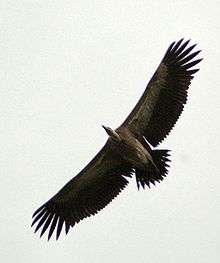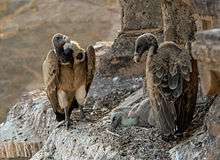Indian vulture
| Indian vulture | |
|---|---|
 | |
| Indian vulture | |
| Scientific classification | |
| Kingdom: | Animalia |
| Phylum: | Chordata |
| Class: | Aves |
| Order: | Accipitriformes |
| Family: | Accipitridae |
| Genus: | Gyps |
| Species: | G. indicus |
| Binomial name | |
| Gyps indicus (Scopoli, 1786) | |
| Synonyms | |
|
Gyps indicus indicus | |
The Indian vulture (Gyps indicus) is an Old World vulture and is closely related to the griffon vulture, G. fulvus. It breeds mainly on hilly crags in central and peninsular India. The birds in the northern part of its range once considered a subspecies are now treated as a separate species, the slender-billed vulture Gyps tenuirostris. These were lumped together under the name long-billed vulture.
Description
The long-billed vulture is a typical vulture, with a bald head, very broad wings and short tail feathers. It is smaller and less heavily built than the Eurasian Griffon, usually weighing between 5.5 and 6.3 kg (12–13.9 lbs) and measuring 80–103 cm (31–41 in) long and 1.96 to 2.38 m (6.4 to 7.8 ft) across the wings.[2][3] It is distinguished from that species by its less buff body and wing coverts. It also lacks the whitish median covert bar shown by Griffon.
Behaviour
The species breeds mainly on cliffs, but is known to use trees to nest in Rajasthan. It may also breed on high human-made structures (like the Chaturbhuj Temple in the picture). Like other vultures it is a scavenger, feeding mostly from carcasses of dead animals which it finds by soaring over savannah and around human habitation. They often move in flocks.
Status and conservation
Population declines

The Indian vulture and the white-rumped vulture, G. bengalensis species have suffered a 99%–97% population decrease in Bangladesh, Pakistan and India. Between 2000-2007 annual decline rates of this species and the slender-billed vulture averaged over sixteen percent.[4] The cause of this has been identified as poisoning caused by the veterinary drug diclofenac. Diclofenac is a non-steroidal anti-inflammatory drug (NSAID) and when given to working animals it can reduce joint pain and so keep them working for longer. The drug is believed to be swallowed by vultures with the flesh of dead cattle who were given diclofenac in the last days of life.
Diclofenac causes kidney failure in several species of vultures. In March 2006 the Indian Government announced its support for a ban on the veterinary use of diclofenac. Another NSAID, meloxicam, has been found to be harmless to vultures and should prove to be an acceptable substitute for diclofenac. When meloxicam production is increased it is hoped that it will be as cheap as diclofenac. As of August 2011 the ban for veterinary use for approximately a year did not prevent diclofenac use across India.[5] Small numbers of birds have bred across peninsular India, in Karnataka and Tamil Nadu.[6]

Captive-breeding programmes
Captive-breeding programmes for several species of Indian vulture have been started. The vultures are long lived and slow in breeding, so the programmes are expected to take decades. Vultures reach breeding age at about five years old. It is hoped that captive-bred birds will be released to the wild when the environment is clear of diclofenac.
In early 2014 the Saving Asia’s Vultures from Extinction (Save) programme announced that it expects to start releasing captive-bred birds into the wild by 2016.[7]
Two captive Himalayan Griffon vultures were released in June, 2016 from Jatayu Conservation Breeding Centre, Pinjore as part of Asia's first vulture re-introduction program. [8]
References
- ↑ BirdLife International (2013). "Gyps indicus". IUCN Red List of Threatened Species. Version 2013.2. International Union for Conservation of Nature. Retrieved 26 November 2013.
- ↑ "The Peregrine Fund". The Peregrine Fund. 2010-11-03. Retrieved 2011-05-31.
- ↑ Raptors of the World by Ferguson-Lees, Christie, Franklin, Mead & Burton. Houghton Mifflin (2001), ISBN 0-618-12762-3
- ↑ "BirdLife Fact Sheet: Indian vulture". BirdLife International. Retrieved 11 August 2014.
- ↑ Jagga, Raakhi (7 August 2011). "Banned diclofenac still kills vultures". Express India. Retrieved 11 August 2014.
- ↑ Oppili, P. (7 November 2013). "Long-billed Vulture sighted after 40 years". The Hindu. Retrieved 11 August 2014.
- ↑ Kinver, Mark (31 Jan 2014). "Project targets 2016 for Asian vultures release". BBC News. Retrieved 2 February 2014.
- ↑ "Asia's first vulture re-introduction programme launched in Haryana".
External links
| Wikimedia Commons has media related to Gyps indicus. |
- Conserving Asia's critically endangered vultures
- Vulture Territory Facts and Characteristics: Long Billed Griffon
- "Saving Asia's Vultures from Extinction" Consortium
